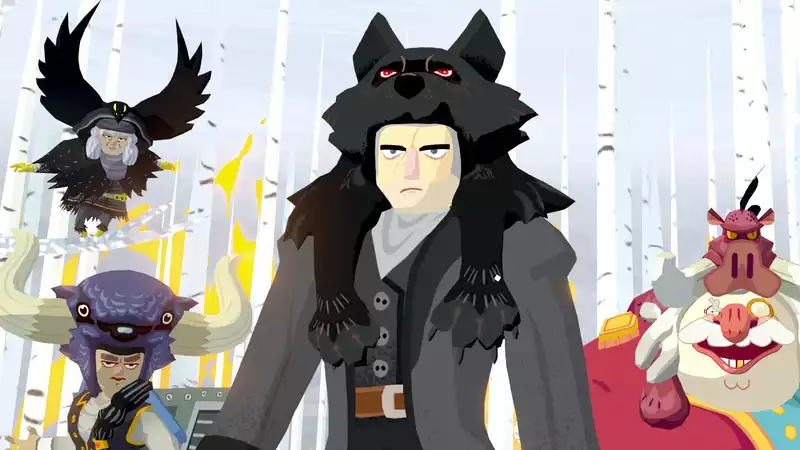A bullet to the head and a near-death experience is a terrible way to end a Friday night. Beaten and bloodied in the snow, Mr. Wolfe is bloodthirsty and takes his picture-perfect frontier on a bloody journey of revenge. But this is what revenge is all about. Revenge may be sweet and best served cold. But even when it is satisfying, Bloodroot's quest for catharsis quickly grows tiresome.
This is bloody, gory revenge. If it weren't for the copious viscera and incessant cursing, you'd think it was lifted straight from a Saturday morning cartoon, Kill Bill rendered with the sharp, bold strokes of the Cartoon Network heyday of the late 90s. Samurai Lumberjack
In each act, Mr. Wolfe screams murder at one of his former friends in a fur suit and turns hundreds of colonial goons to splinters in the process. It's crass and straight-forward, but it's enough to repeat the carnage. Eventually, you'll talk with the bloody ghosts of your former comrades around the campfire that serves as both a place of explanation and a base of operations. From here, you can replay the mission, try on a new hat, or head out into the wilderness to turn the forest red.
But once you venture into that painted wilderness, all safeguards are removed. Each level is divided into a series of arenas: farms, barns, towns, and mansions crowded with colonial goons. Everyone, including yourself, operates under the same one-hit-kill rule. It doesn't matter whether you hit them with your bare hands, a chainsaw, or a freshly picked cabbage. It's "Hotline Miami" on the Canadian frontier.
Whenever Bloodroots' bag of tricks starts to feel thin, throw something completely new into the mix. Each level brings a new twist to the battle. The iron brat who takes an extra blow to take you down. The cowardly sniper who can't tell friend from foe and fires highly sophisticated bullets that, if carefully baited, will easily knock down the bad guys. But this is not a one-sided arms race. As the enemy's arsenal builds up, so does your own. New weapons begin to litter the environment. Some, such as axes and planks, can hit things more efficiently. Others help to keep pests at bay. Plungers stick into the poor guy's head. Hay bales stagger and confuse the enemy. Unless, of course, they kick in the bonfire and set the poor lad ablaze.
But the best tools are the ones that completely change the way you step through the death traps of the frontier. Ladders are great for knocking things over, but propped up against a wall, they can dash you to new levels. Paddles make for amazingly skillful pole vaulting. Swords can dash through gaps and rush through traps with a gravity-defying dash, but they can also chop down trees like an axe to open up new routes.
Even in the arena, different elements begin to mix. Barrels and tires can be run on to overcome spikes that litter the floor. Wagons can be looted for their wheels (they are handy killer Frisbees), but with wheels on, sediment caught in your path can be roadkill. Cannons are a nightmare to deal with, but kill the gunner and poor Mr. Wolfe can have a new career as a human cannonball.
The Bloodroots arena is a brutal murder puzzle at its best. You have to slaughter your way through tight, multi-layered complexes and cliffs in the best way possible. You have to dive headfirst into danger, scout new paths, and rethink your plan until you find the right route with the right tools.
At its worst, however, the game is a repetitive grind: while Bloodroots' arenas work if they are compact, Paper Cult instead often opts for sprawling gauntlets, with one trap or ambush screen after another, and a single mistake can send can set you back many minutes. I'm ashamed to admit that once or twice, just when I thought I had beaten the last guy, I fell into a pit or tripped over a spiky spike. bloodroots doesn't auto-save until the battle starts, so you're right back at the beginning. Nonsense.
That frustration peaked with the game's first boss. Chasing after a small man wearing a boar hat and piloting a flying contraption, the player had to navigate through a gauntlet of linear platforming. There are few save points, and it's all rote memorization. I quit the game several times, exhausted, until I finally knocked his head off my shoulders.
That's the problem: Bloodroots looks phenomenal and plays just as well in its best moments. But much of the big package feels careless. For example, I couldn't figure out how to get the axe in the prologue, which led to an annoying lack of operational prompts. It's at the down arrow. Sure, I figured it out. But the real culprit is this lack of pacing: the levels in Bloodroots are not long, but they are terribly tedious. As the novelty of finding and playing with a new murderous toy grows, the exhaustion wears off. It's hard to ignore the fact that I often quit the game after the eighth or ninth time through the same mansion, or worse, after completing a lifeless, forced "bonus" level. [Perhaps the fairest thing to say about playing Bloodroots is that it is like taking care of a dog. Not a well-behaved dog, but a true mutt. It's a goofy, noisy, complex beast under its dirty fur, and I want to love it. But I'm tired of keeping it in the house.
.

Comments